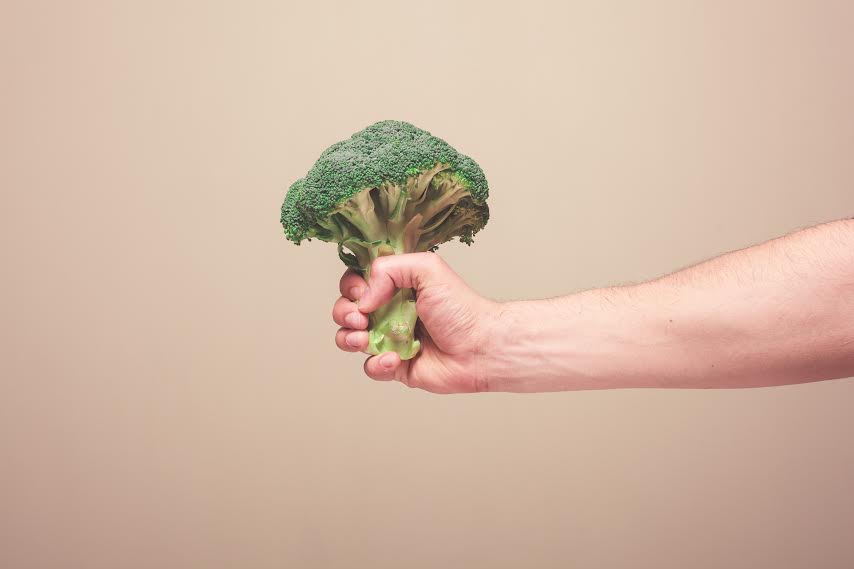There are many misconceptions of a plant-based diet. From a simple lack of variety and being deficient in protein, to contributing to sub-optimal nutrition for physical performance and mental clarity.
I beg to differ.
Since turning vegan, and then helping clients to harness the benefits of a nutrient and fiber-rich diet, I believe that a plant-based diet is the elixir of life on all levels. Improved detoxification, better body composition with less training, increased energy levels and strength gains are just the tip of the iceberg for the plant-based perspective.
In order to thrive on a plant-based diet, what one needs to focus on is nutrient-dense calories from whole plant sources. Based on my experience, this is what I have found works for me and for the clients that I've worked with.

1. Start your day with a green blend
I believe in starting the day with a green smoothie. It is the best way to consume a large amount of fruits and vegetables in one go. A green smoothie consists of a variety of fruits and vegetables blended together.
This morning blend will provide you with the necessary phytonutrients, vitamins, minerals, and soluble and insoluble fiber to help nourish your cells and facilitate the body's natural detoxification process.
If you happen to miss a meal or two and find it a struggle consuming a healthy amount of fruits and vegetables, having a green smoothie at the start of your day will give a boost to your energy levels.
Opt for local and seasonally available fruits and vegetables. Do a search online to find out where farmers markets are held in your local area. You can also search online for recipe ideas and get creative with your smoothie!
Here's one simple green smoothie recipe that I love:
Alka-Banana smoothie
Ingredients:
1 banana
1 date
½ a lemon (skin removed)
Handful of spinach
2 stalks of kale
Small sprig of cilantro/coriander
2 cups of water (to desired consistency)
5 or 6 ice cubes
Sprinkle of cinnamon powder on top
Method:
Put all the ingredients in a blender and blend!

2. Protein
This is the word on everyone's mind! There are many perspectives on this macronutrient, including how much to have and what protein sources are best. There are even diet perspectives — High carbohydrate/low fat (eg: 80/10/10), high protein/low carb, high protein/high fat — this list gets longer all the time. I believe that there is a misconception about how much protein we actually need to consume in order to thrive.
Contrary to popular belief, the RDA for protein according to the World Health Organization (W.H.O) is 0.8g/kg of body weight (0.8g/2.2 lbs.). This means that for an average male weighing 80kg (approx. 176 lbs.), his protein requirement is 64 grams per day. There are even some individuals who thrive on a 90% carbohydrate, 5% fat, and 5% protein ratio.
Protein requirements really depend on your goals, and there is no one-size-fits-all approach. Based on my experience working with clients, I adopt a range of between 1.3-2 x bodyweight to calculate protein requirements. So, taking an average 80kg male, the range would work out to be between 104g-160g of protein daily.
Not only is it easy to hit your protein goals on a plant-based diet (see below), plant-fueled individuals have experienced enhanced recovery, increased strength gains, and are able to stay leaner all year round, with less training.
Where do you get your protein?
80kg male @ 1.6 x bodyweight = 128g of protein
Meal 1: Green smoothie (various fruits and vegetables) = 8g
Meal 2: Quinoa breakfast porridge = 10g
Meal 3: Lentil/bean salad = 30g
Meal 5: Post-workout protein shake = 30g
Meal 6: Tofu stir-fry with vegetables = 35g
Snack: handful of raw nuts, fruits = 15g
Total protein count: 128g

3. Consuming sufficient nutrient-dense calories
As they say, a calorie isn't just a calorie. There are a whole host of factors — nutrient-density, organic/non-organic, raw/cooked, etc. — that could determine the nutrient/energy yield from a specific food. Depending on body type, hereditary background, body composition, and performance goals, the caloric model on a plant-based diet is just one aspect of achieving optimal health and wellbeing.
Although it is not necessary to calculate your caloric needs on a plant-based diet, I tend to use the Harrison Benedict formula (http://en.wikipedia.org/wiki/Harris%E2%80%93Benedict_equation) to calculate caloric client requirements, as a reference point.
To work out overall daily caloric requirements based on an individual's Basal Metabolic Rate (BMR), the calculation is as follows:
Women
655 + (4.35 x weight in pounds) + (4.7 x height in inches) — (4.7 x age) = (Approximate BMR in calories required)
Men
66 + (6.23 x weight in pounds) + (12.7 x height in inches) — (6.8 x age) = (Approximate BMR in calories required)
The next step is factoring activity level of the individual:
Sedentary - No exercise | BMR x 1.2 |
Light activity — Exercising 1 — 3 times a week | BMR x 1.375 |
Moderate activity — Exercising 3 — 5 times a week | BMR x 1.5 |
Active — Intense exercise 6-7 times a week | BMR x 1.725 |
Extreme — Intense exercise twice per day, 6-7 times per week, or very physical occupation | BMR x 1.9 |
The final figure will give you an idea of your caloric requirements based on your level of activity.
4. Keep it whole and keep your fats low
Taking into consideration the three points above, I'd recommend including a majority of foods that are close to their natural source. Foods such as:
Whole grains
Fruits and vegetables
Legumes
Nuts & Seeds (sparingly)
As conventional crops often contain chemically derived herbicides, pesticides, and fertilizers, opt for organic where possible, especially with these specific fruits and vegetables, which tend to be heavily sprayed (Read the &aps;Dirty Dozen')
Apples, Strawberries, Grapes, Celery, Peaches, Spinach, Bell peppers, Nectarines, Cucumbers, Potatoes, Cherry tomatoes, Hot peppers, Squash
I tend to opt for a lower fat approach in my own diet, and limit or exclude refined oils where possible. I try not to exceed 75% of my bodyweight (in kilograms) in grams of fat per day.
Good fats that I tend to incorporate into my diet include:
For cooking - Organic Cold Pressed Coconut Oil, Organic coconut milk
Omega 3 supplementation - Chia seeds and Flax seeds
Various nuts and seeds - Pumpkin seeds, raw activated almonds/brazil nuts etc.
Example:
80kg male x 75% = 60g of fat/day (where 1g of fat = 9 calories)
I believe that everyone's nutritional requirements are different, and it is through trial and error that you will find what works or does not work for you. Depending on what you are trying to achieve, aim to work with a coach who shares your beliefs and has a vested interest in your goals, not their own.
Luke Tan
Vegan Strength and Empowerment Coach
www.evolvedgeneration.com/team/luke-tan



Recommended Comments
There are no comments to display.